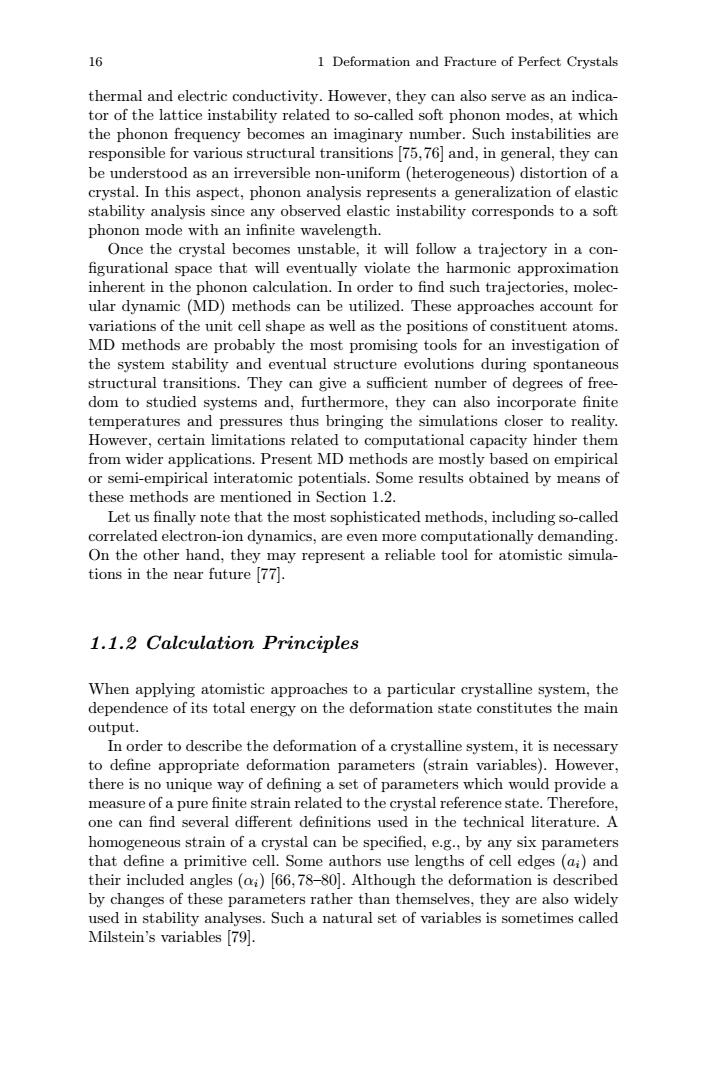正在加载图片...

16 1 Deformation and Fracture of Perfect Crystals thermal and electric conductivity.However,they can also serve as an indica- tor of the lattice instability related to so-called soft phonon modes,at which the phonon frequency becomes an imaginary number.Such instabilities are responsible for various structural transitions [75,76 and,in general,they can be understood as an irreversible non-uniform (heterogeneous)distortion of a crystal.In this aspect,phonon analysis represents a generalization of elastic stability analysis since any observed elastic instability corresponds to a soft phonon mode with an infinite wavelength. Once the crystal becomes unstable,it will follow a trajectory in a con- figurational space that will eventually violate the harmonic approximation inherent in the phonon calculation.In order to find such trajectories,molec- ular dynamic (MD)methods can be utilized.These approaches account for variations of the unit cell shape as well as the positions of constituent atoms. MD methods are probably the most promising tools for an investigation of the system stability and eventual structure evolutions during spontaneous structural transitions.They can give a sufficient number of degrees of free- dom to studied systems and,furthermore,they can also incorporate finite temperatures and pressures thus bringing the simulations closer to reality. However,certain limitations related to computational capacity hinder them from wider applications.Present MD methods are mostly based on empirical or semi-empirical interatomic potentials.Some results obtained by means of these methods are mentioned in Section 1.2. Let us finally note that the most sophisticated methods,including so-called correlated electron-ion dynamics,are even more computationally demanding. On the other hand,they may represent a reliable tool for atomistic simula- tions in the near future 77. 1.1.2 Calculation Principles When applying atomistic approaches to a particular crystalline system,the dependence of its total energy on the deformation state constitutes the main output. In order to describe the deformation of a crystalline system,it is necessary to define appropriate deformation parameters (strain variables).However, there is no unique way of defining a set of parameters which would provide a measure of a pure finite strain related to the crystal reference state.Therefore, one can find several different definitions used in the technical literature.A homogeneous strain of a crystal can be specified,e.g.,by any six parameters that define a primitive cell.Some authors use lengths of cell edges (ai)and their included angles (a:)66,78-80].Although the deformation is described by changes of these parameters rather than themselves,they are also widely used in stability analyses.Such a natural set of variables is sometimes called Milstein's variables [79].16 1 Deformation and Fracture of Perfect Crystals thermal and electric conductivity. However, they can also serve as an indicator of the lattice instability related to so-called soft phonon modes, at which the phonon frequency becomes an imaginary number. Such instabilities are responsible for various structural transitions [75,76] and, in general, they can be understood as an irreversible non-uniform (heterogeneous) distortion of a crystal. In this aspect, phonon analysis represents a generalization of elastic stability analysis since any observed elastic instability corresponds to a soft phonon mode with an infinite wavelength. Once the crystal becomes unstable, it will follow a trajectory in a con- figurational space that will eventually violate the harmonic approximation inherent in the phonon calculation. In order to find such trajectories, molecular dynamic (MD) methods can be utilized. These approaches account for variations of the unit cell shape as well as the positions of constituent atoms. MD methods are probably the most promising tools for an investigation of the system stability and eventual structure evolutions during spontaneous structural transitions. They can give a sufficient number of degrees of freedom to studied systems and, furthermore, they can also incorporate finite temperatures and pressures thus bringing the simulations closer to reality. However, certain limitations related to computational capacity hinder them from wider applications. Present MD methods are mostly based on empirical or semi-empirical interatomic potentials. Some results obtained by means of these methods are mentioned in Section 1.2. Let us finally note that the most sophisticated methods, including so-called correlated electron-ion dynamics, are even more computationally demanding. On the other hand, they may represent a reliable tool for atomistic simulations in the near future [77]. 1.1.2 Calculation Principles When applying atomistic approaches to a particular crystalline system, the dependence of its total energy on the deformation state constitutes the main output. In order to describe the deformation of a crystalline system, it is necessary to define appropriate deformation parameters (strain variables). However, there is no unique way of defining a set of parameters which would provide a measure of a pure finite strain related to the crystal reference state. Therefore, one can find several different definitions used in the technical literature. A homogeneous strain of a crystal can be specified, e.g., by any six parameters that define a primitive cell. Some authors use lengths of cell edges (ai) and their included angles (αi) [66, 78–80]. Although the deformation is described by changes of these parameters rather than themselves, they are also widely used in stability analyses. Such a natural set of variables is sometimes called Milstein’s variables [79]